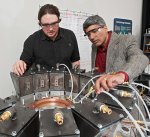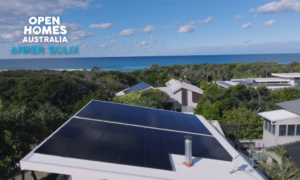Hydrogen as a clean fuel is particularly alluring as an abundant source – water – is something the Earth isn’t short of. However, to split hydrogen from water is incredibly energy intensive. Using fossil fuels as the source of energy would defeat much of the purpose of hydrogen fuel, so researchers have turned to renewable sources.
A couple of days ago, we reported on how butterfly wing biomimicry was being used in conjunction with the power of the sun to split water into hydrogen and oxygen.
Harvesting the sun’s energy to assist in the production of hydrogen fuels is being pursued by a number of other researchers, including University of Delaware’s Erik Koepf. A doctoral candidate in mechanical engineering, Mr. Koepf is working on a reactor that uses highly concentrated sunlight and zinc oxide powder to produce hydrogen.
Light concentrated to the equivalent of 10,000 suns will be focused down into the reactor, generating temperatures of over 1,600 degrees Celsius. Once the desired temperature is reached, zinc oxide powder will enter into the system through 15 hoppers located on top of the device. The powder will be deposited onto a ceramic layer, initiating a reaction that will create zinc vapor. In the next step, the zinc will react with the water to create hydrogen.
Rather than being a wasteful process, the zinc oxide by-product created during the reaction can be used again, making the project self-sustaining.
Small as the reactor may look, it’s a hefty beast; weighing in just shy of 800 kilograms. The weight is largely due to the ultra-high temperature insulation and ceramic materials needed to maintain a high temperature environment, while also keeping the housing for motors and other equipment cool.
Starting yesterday, Koepf commenced six weeks testing the prototype’s effectiveness using the ingredient missing so far in his development – the sun – at the Swiss Federal Institute of Technology in Zurich.
One of Koepf’s advisers, Jay Prasad, professor of mechanical engineering and director of UD’s Center for Fuel Cell Research, is very impressed with progress to date; stating it was probably the most complex device built by a graduate student in the history of the department
Source/image source














































